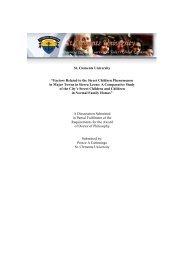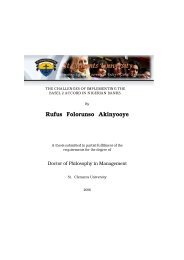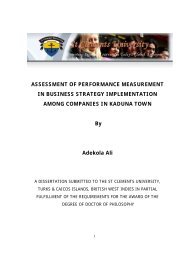CHURCH AWARENESS AND PRACTICE OF TOTAL QUALITY ...
CHURCH AWARENESS AND PRACTICE OF TOTAL QUALITY ...
CHURCH AWARENESS AND PRACTICE OF TOTAL QUALITY ...
You also want an ePaper? Increase the reach of your titles
YUMPU automatically turns print PDFs into web optimized ePapers that Google loves.
year, TQM is focused on medium to long term benefits, thereby ensuring constant<br />
improvement over time.”<br />
2.1:5 Quality Circles: These are Japanese approach to quality which they started in Japan<br />
after the second world way. A Quality Circle offers participatory management<br />
opportunity to employees. It is a worker motivator that creates a working climate of trust.<br />
Glover (1993) and Ouchi (1981), said “first, however, employees must sense a climate of<br />
trust before they can offer maximum commitment to TQM. A climate of trust permits<br />
employees to be sold on a project.” Kelvin Wilson-Smith, TQM manager at Gestetner in<br />
an e-library printable article (2002) said “this model has allowed Gestetner to improve its<br />
offering on all fronts. Since implementing the TQM methodology, we have found it a<br />
practical driving tool, inspiring employees to improve upon both processes and service.”<br />
John S. Oakland (1989, P252) defines quality circle “as a group of workers doing similar<br />
work who meet voluntarily, regularly, in normal working time, under the leadership of<br />
their supervisor, to identify, analyze, and solve work related problems and to recommend<br />
solutions to management.”<br />
Oakland thinks that where it is possible, members of a quality circle should be allowed to<br />
carry out their own recommendations. Why? because the commitment will be there to<br />
implement and see to it that maximum “profits” are obtained there from.<br />
However, Kit Sadgrove (1995, P78) observed that quality circles are not labour unions;<br />
as such they cannot discuss pay and conditions of service because these are meant to be<br />
negotiated. They can also not discuss individual people because personnel problems must<br />
be handled professionally. “Everything else is suitable,” he said. In the Church setting in<br />
Nigeria, quality circles are represented by what is called committees or groups of various<br />
types with various names from denomination to denomination. Thus we have “harvest<br />
committee,” building committee,” “special project committee,” “counseling committee,”<br />
“hospitality committee” and so on and so forth. Each of these committees works for the<br />
interest of all, some of them like the “progress committee” and “prayer committee” work<br />
continuously year in year out. Each committee makes recommendations to the Church<br />
Leadership who takes final decisions and executes such decisions sometimes through the<br />
committees or by themselves.<br />
2.1:6 Beyond Quality: Before the present hyper philosophies and sometimes-complex<br />
complications which competitive activities have fostered on the world, it used to be<br />
simple production based on some possible measure of quality. Measure of quality kept<br />
through simple quality control observations. But that has since become history.<br />
The industrial temperature has almost read up all the degrees on the thermometer! That<br />
makes the arrival of TQM a great human discovery and its fire is catching on more and<br />
more worldwide. Byrne, 1992, Gagne, 1983, Lowe et al, 1986 all agree that “TQM<br />
provides a paradigm shift in management philosophy for improving organizational<br />
effectiveness.” One of the tools of TQM for effective working is beyond quality concept.<br />
An organization will say to itself and staff that for our product or service to beat<br />
competition and keep us in business continuously, we must daze the customers beyond
















